Indian Super League (ISL) has come a long way since its inception in 2014. The league which is now considered to be the topmost league toppling I-League in India is actually an amalgamation of the league system as well as the knockout system. The ten teams fight to qualify for the two-legged semi-finals and the knockout phase decides the champion of the season.
ISL has become the hub for the National coaches to look into for summoning players to the national squad, with only one I-League player being called to the national side since January of this year. Although I-League is no short of talent, it’s often being overlooked.
One team that has grown immensely each passing season is FC Goa. Sergio Lobera was appointed as the manager of FC Goa in 2017 and it was a vital moment in the history of Indian football. He became one of the reasons Indian clubs and the national team started to look forward to the passing style of play rather than playing long balls to the target-man.
The Gaurs played some mesmerising football throughout the last season but eventually lost to Bengaluru FC in the final. The five games Goa played this season though have been a topsy turvy path. Let’s dive deep into the tactics of Sergio Lobera’s FC Goa.
This tactical analysis focuses on the tactics used by Sergio Lobera and analysis of FC Goa.
Formation
Sergio Lobera loves to play with 4-2-3-1 but occasionally changes to 4-4-1-1 which again looks alike 4-2-3-1. He has hardly tinkered with the formation in more than two years and still produces a brand of football which the opponents often fail to intercept.
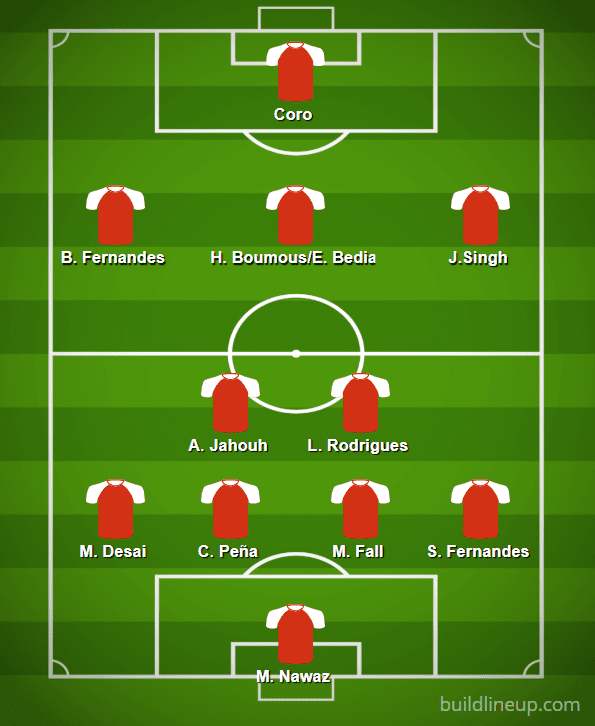
This is the lineup Goa usually plays with. Mohammed Nawaz has made the goalkeeper position his own under Lobera. He is well suited to the passing football FC Goa has adopted. Carlos Peña and Mourtada Fall are stationed at the heart of the defence. Seriton Fernandes is used as the right-back and Mandar Rao Desai is used as the makeshift left-back. Mandar started his career as a midfielder but Lobera uses Mandar quite potently in the left-back position.
Ahmed Jahouh and Lenny Rodrigues acts as the double pivot and provides the extra shielding to the defenders. Brandon Fernandes and Jackichand Singh are used as wingers and they perform different roles for the Goa manger. Jackichand is used more in an advanced role and the Goa manager utilises Brandon’s passing skill by using him in a deeper role. Hugo Boumous and Edu Bedia are rotated in the attacking midfield position and the two times Golden Boot winner Spanish forward, Ferran Corominas is ever-present in the Goa lineup.
However, due to frequent injuries and card issues to Bedia, Boumous and Jahouh this season, the Goa manager had to tinker the personnel in few positions. Jahouh’s absence meant Brandon to occupy the midfield position alongside Lenny. Corominas falls deep in case Bedia and Boumous are absent and occupies ‘the hole’. Manvir Singh takes the role of a striker and the pacey winger Seminlen Doungel occupies the left-wing position.
Style of play
The Spaniard spent his initial years as the coach of Barcelona youth teams and acquired the DNA of Barcelona’s passing football. The Gaurs build up from the back but mixes their play with long balls along with short passes.
While in possession, FC Goa shuffles between 4-2-3-1 and three-man backline.
The Gaurs usually maintain the same 4-2-3-1 set up like the initial one. However, if the opposition marks their two midfielders and makes it hard for their midfielders to carry the ball forward, one of the midfielders drops slightly deeper and the ball playing centre-back, Peña makes a run into the empty space and looks for a forward passing option.
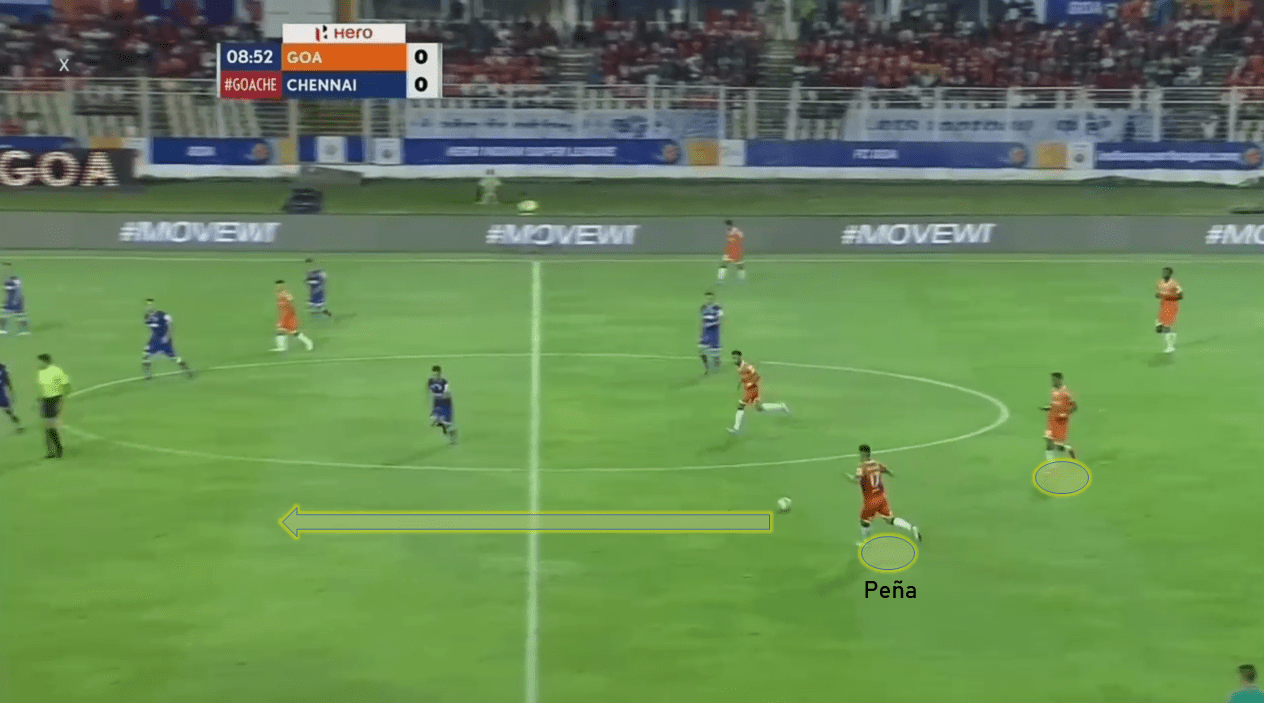
This is a rare situation. In most cases, one of the midfielders drops deep to form a three-man backline. The Moroccan midfielder, Jahouh is usually the one who falls back to form a three-man backline owing to his composure in playing short passes and produce defence splitting long balls and diagonal balls. In the four games the midfielder played this season, he produced 13.38 long balls with 60% accuracy. Last season he recorded even more long balls. He played 14.32 long balls with better accuracy of 64.6%. He is the best midfielder in the league when it comes to long balls.
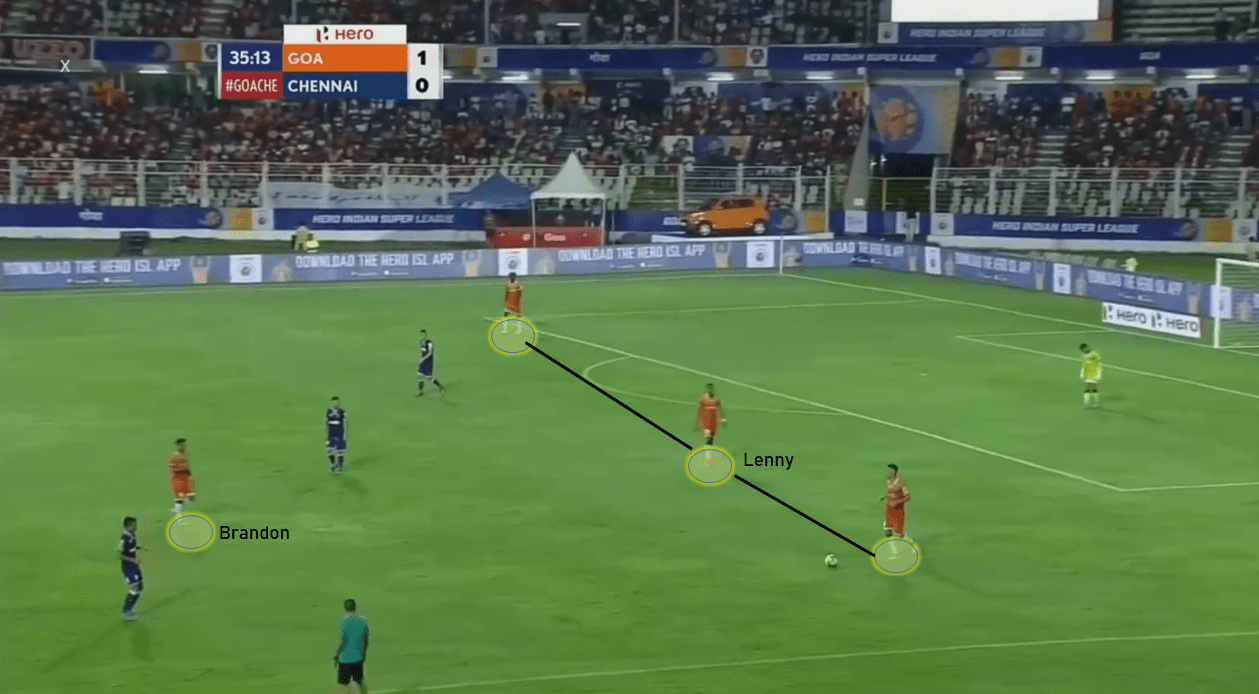
Against Chennaiyin FC, Brandon and Lenny started in the midfield owing to Jahouh’s absence. Lenny positioned himself in a deeper role as the central defensive midfielder. He dropped back to form a three-man backline which usually is performed by Jahouh. Brandon is in the midfield acting as the link between the defenders and the attackers and the full-backs are pushed up to join the attackers.
This left Brandon in a crowded area of Chennaiyin attackers. Corominas who played in the attacking midfield position dropped a little deep to open a passing channel but not too deep. Peña and Fall played long balls to his path.
However, when Boumous occupies the attacking midfield position and Corominas plays as a striker, it is often seen Boumous drops much deeper to open up a passing lane for the defenders as well as carry the ball forward.
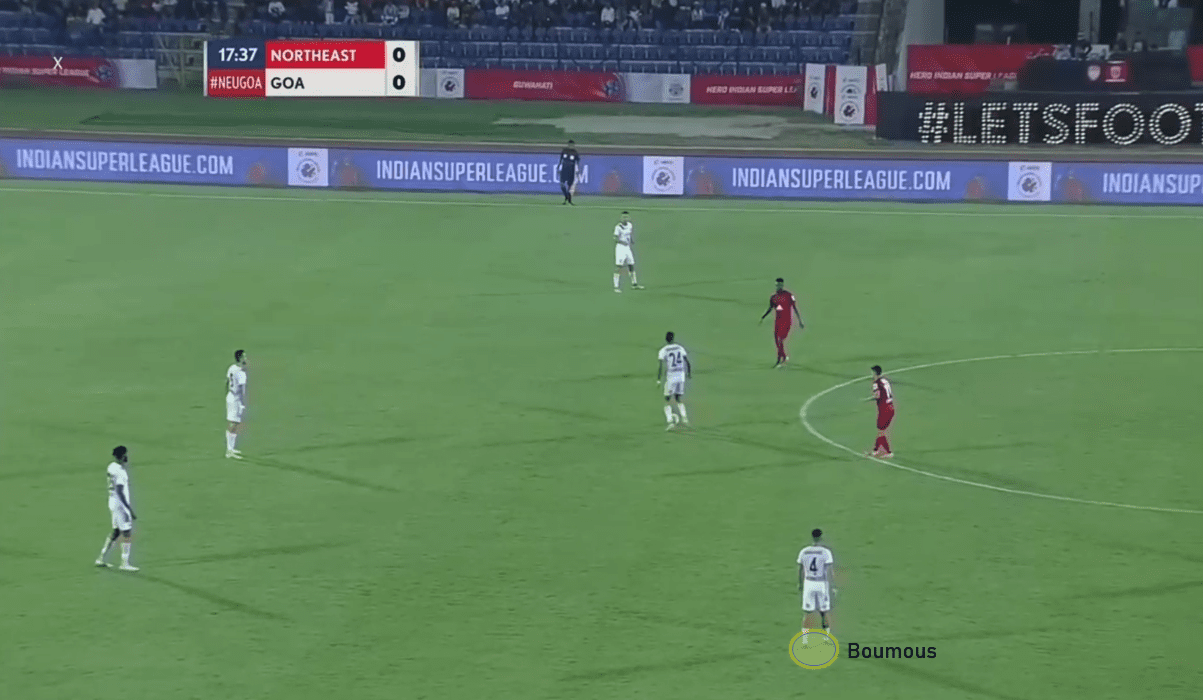
Against NorthEast, Lenny and Jahouh acted as the two pivots. When Jahouh dropped to form a three-man backline, Lenny stationed himself in the midfield. He was constantly ‘pendulum pressed’ by the opposition striker and the attacking midfielder. Boumous dropped deep to form a two-man midfield along with Lenny and thus opening up a passing lane for his team.
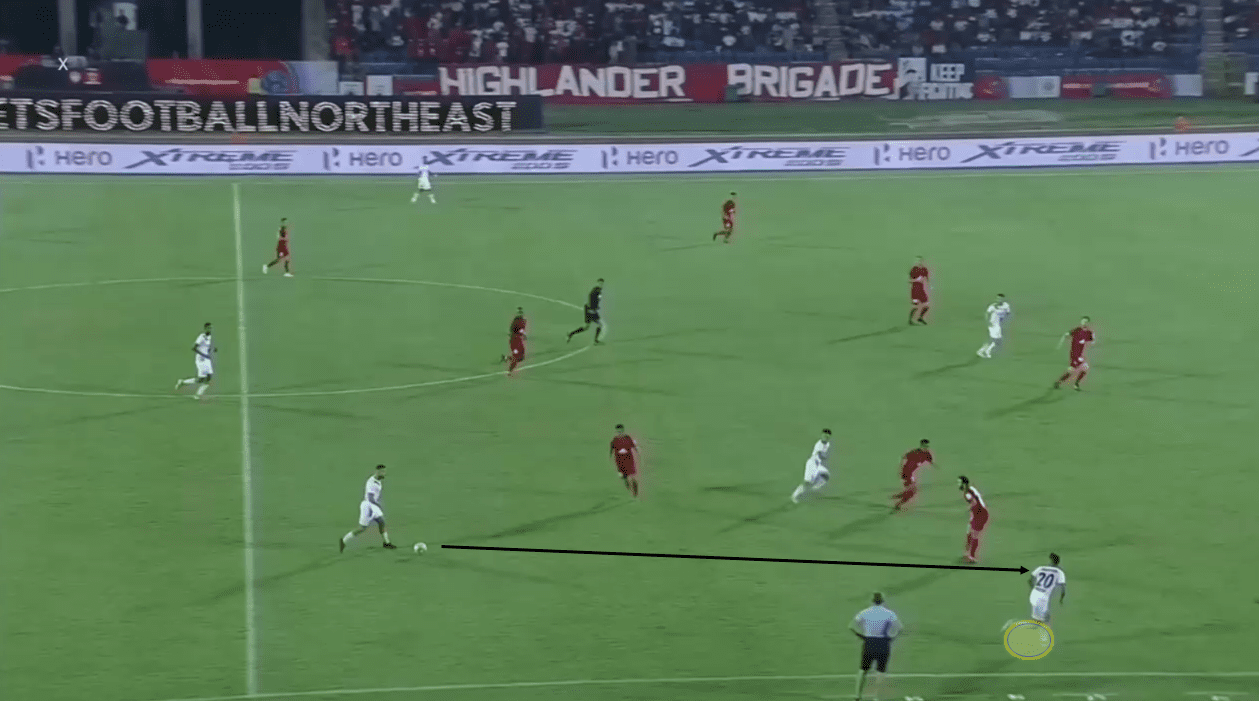
Boumous positioned himself in a position where he was marked by no one and had enormous space and time to carry the ball forward. When he carried the ball forward, one of the NorthEast midfielders moved ahead and tried to block his path. Jackichand drifted inwards occupying the half-space. It drew out the opposition left-back along with him. Goa right-back made an overlapping run. He was not well marked by the NorthEast left-winger. Boumous made a forward pass to the right-back, Seriton to take advantage of the free space in front of him.
FC Goa often confuses the opponents with these type of build-up play.
Attacking Puzzles with Brandon as a left-winger
The Spanish coach loves to play with 4-2-3-1, as mentioned above. However, he has a variety of variations at his disposal, when it comes to the attacking aspect of the game.
Brandon Fernandes started his career as a midfielder but due to his enormous passing range and ability to read the game, Sergio Lobera does not drop him to the bench even when Jahouh is able to play the match. Instead, the Spaniard uses him as a makeshift left-winger.
When Brandon is stationed in the left-wing he often drops deeper making way for the left-back, Mandar, to make overlapping runs. When he drops deep, he also draws out the opposition right-back from his usual position leaving a lot of space for the overlapping left-back to take advantage of.
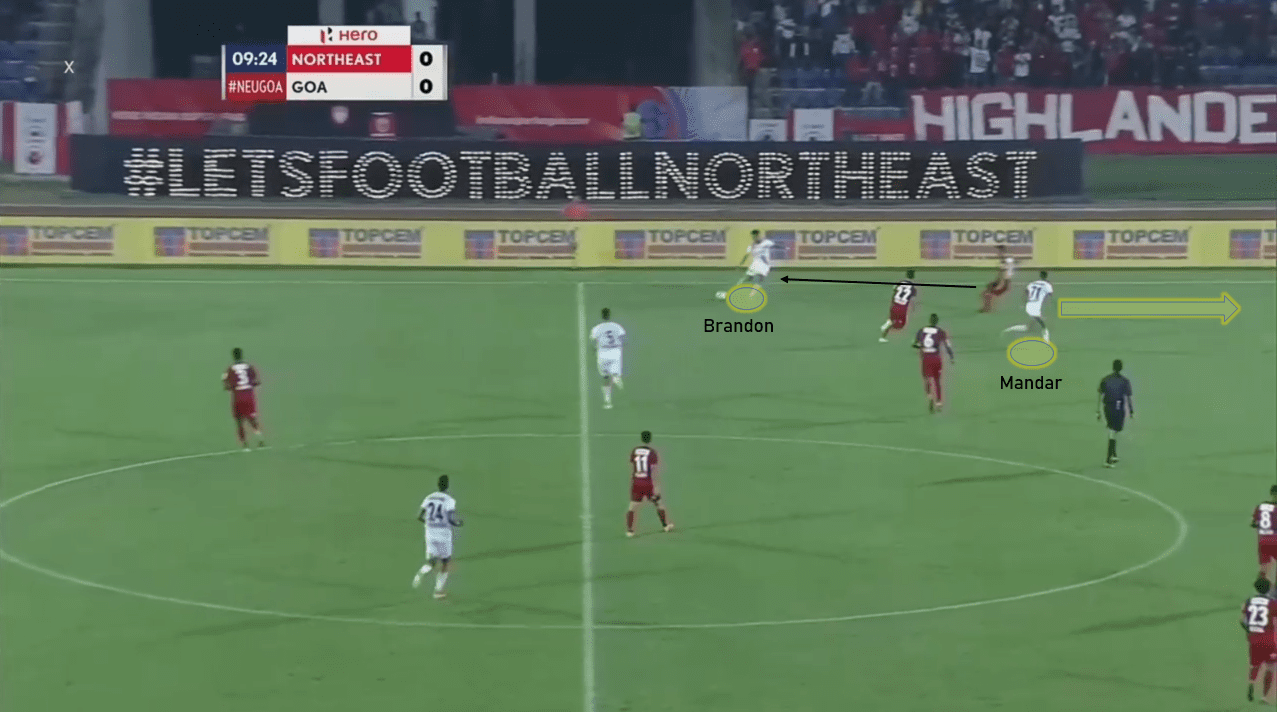
In this match against NorthEast United, the Gaurs try to play out from the back. The centre-backs exchanged few passes and Peña passed the ball to Brandon who dropped a bit deep. Brandon scanned the opposition area beforehand and played a first time pass to the overlapping left-back. Brandon’s positioning pulled out the NorthEast right-back from his defensive setup which left a bit of space for Mandar to attack. The Goa midfielder put too much of weight in the pass and the ball was cleared away by one of the North-East centre-backs.
The other variation to this setup is that Brandon often drifts infield occupying the position in which he had honed his skills and engages the opposition midfielders.
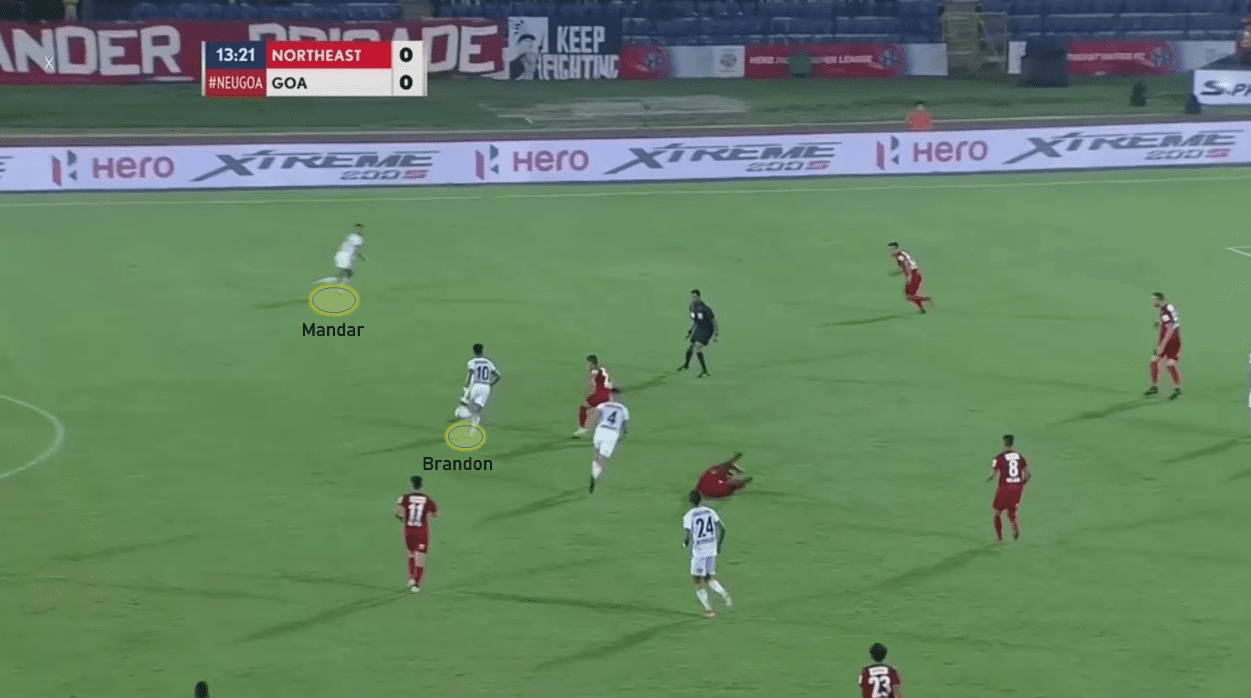
In the same game against NorthEast, Brandon moves infield leaving the entire space for Mandar to operate. What it does is that it leaves Mandar one on one with the opposition right-back. The right-winger of NorthEast is engaged with Brandon in the midfield who can’t immediately shuffle to his original position to create an overload in the right-flank.
These two variations are often seen in the left-flank when Brandon is stationed in the left-wing.
Attacking puzzles with Brandon in the double-pivot and Corominas as the attacking midfielder
When Brandon acts as a midfielder Doungel and Jackichand positions themselves in the left and right wing respectively. However, during Goa attacks, they move inward leaving their original position and positions in the half-spaces between the defenders. The full-backs, Seriton and Mandar makes overlapping runs and pushes themselves in the final third to help with the attacks. This is similar to Liverpool’s structure under Jürgen Klopp when they attack.
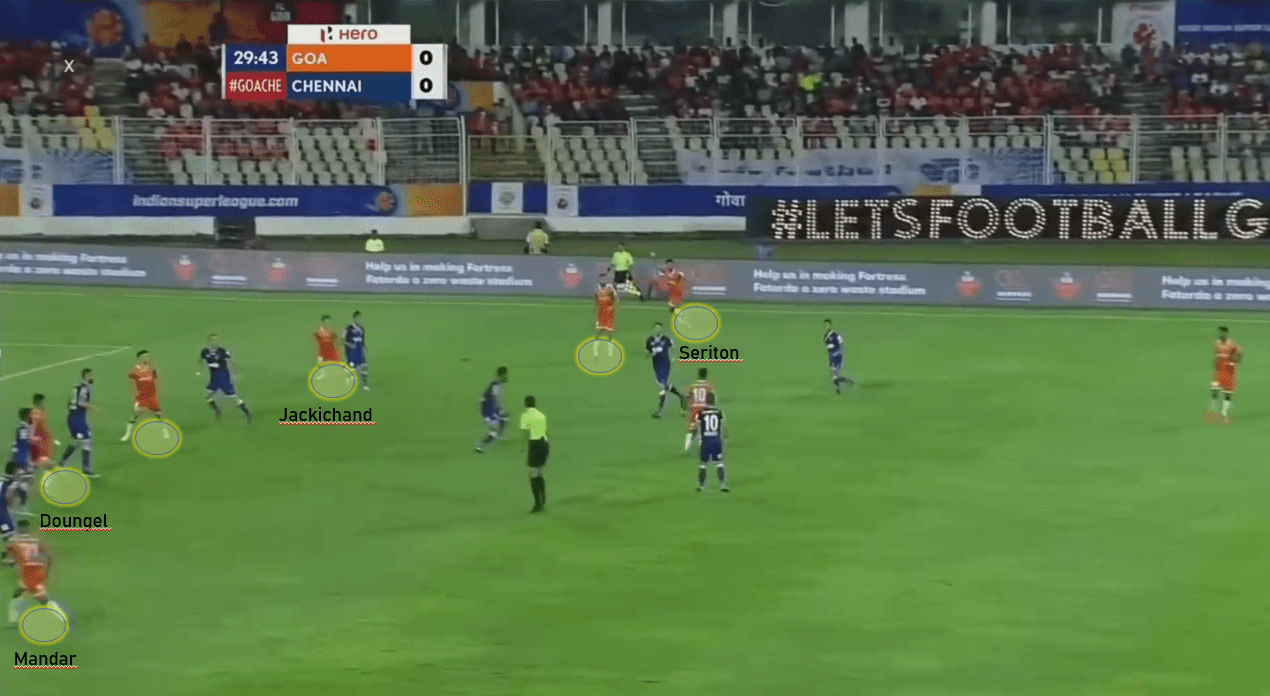
In one such situation against Chennaiyin FC, Mandar and Seriton are the widest making the overlapping runs. Jackichand and Doungel positions themselves in the half-spaces. The right side of the midfield is completely free. The number 10, Brandon analyses the situation and provides a lofted ball to the overlapping Seriton. The Chennaiyin left-back moves towards him and prevents him from crossing. However, that created free space for Manvir Singh, the forward, who positioned himself just at the edge of the box. He made his strides in the box and provided a low cross for a Chennaiyin defender to clear but it ricocheted against Doungel and Goa scored their opener.
The positioning of two midfielders should be noted in this screenshot. Brandon is at the edge of the final third and helping in building the attack. Lenny is at the heart of the midfield who can prevent a counter-attack in case Brandon loses the ball.
Another aspect of Goa’s game irrespective of the lineup is that their forwards often drop a little deeper. When the forward drops deep it draws out a centre-back from the defensive setup. It allows the other attackers to attack the space left behind by the centre-back.
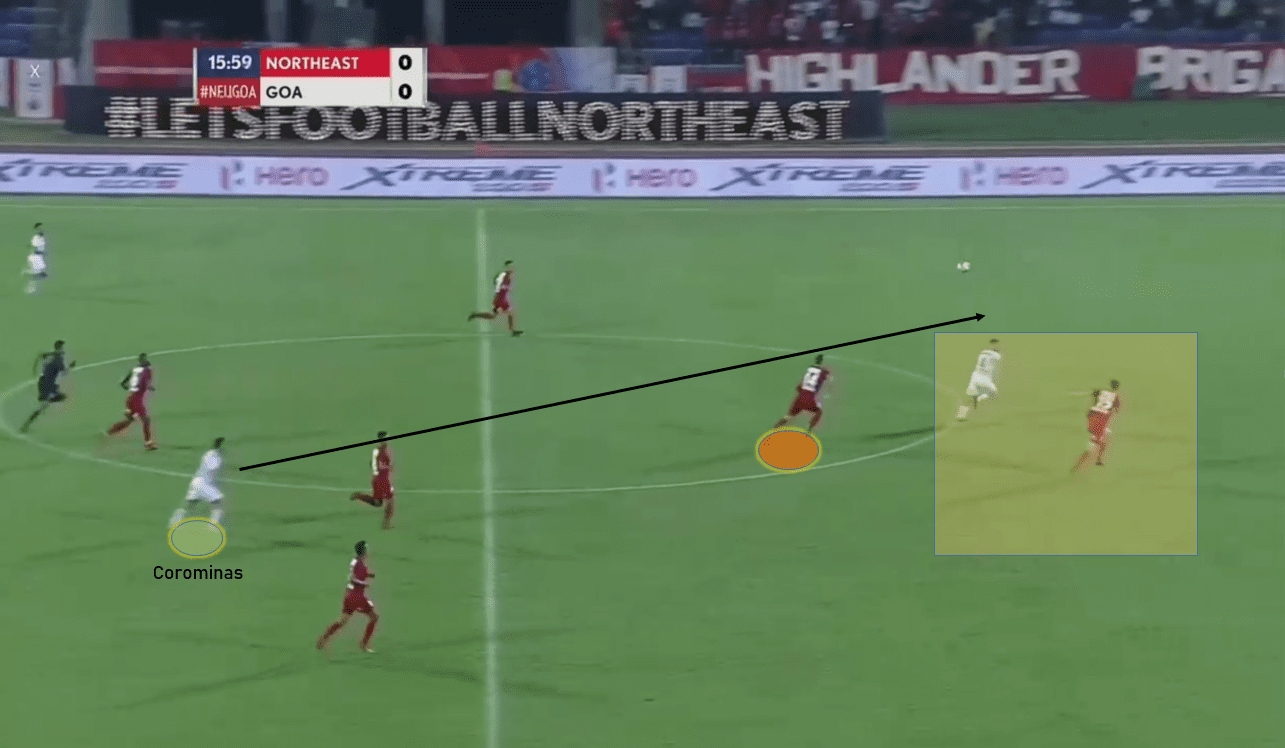
In the game against NorthEast, Corominas, the striker for the game, dropped deep, it drew out an opposition centre-back along with him. Jahouh put a long ball from the box to Corominas’s path. He held the ball and put another long ball in the path of the attacking midfielder Boumous. It left him 1 vs 1 with the opposition centre-back. In this image, it is also seen the centre-back whom Corominas drew out from the defensive setup is running back to stop Boumous from scoring. Unfortunately for FC Goa, the attacking midfielder hit the post.
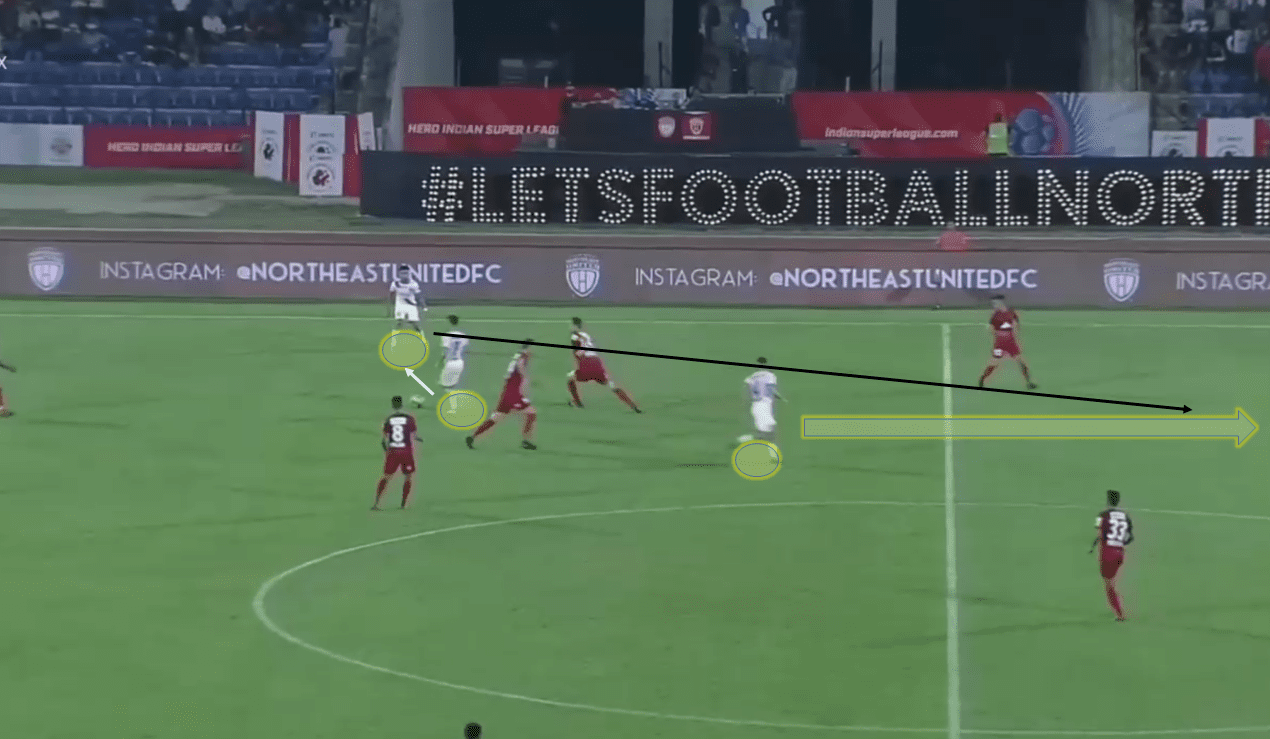
In the same game a few minutes later, Goa scored the first goal of the match creating the same situation. Peña delivered a long ball to Corominas who dropped down. Boumous occupied the space left by Corominas and attacked the space. Corominas passed the ball to Brandon who produced a first time ball to Boumous to put it past the NorthEast goalkeeper.
Sergio Lobera has instilled a beautiful and smooth one-touch passing in the Indian football circuit.
Defensive Setup
FC Goa mixes up their pressing, sometimes goes in aggressively and sometimes prefers to just sit back and man-mark and block the passing lanes.
When the players decide to sit back, they defend with 4-4-2, with the striker and the attacking midfielder upfront and the wingers along with the midfielders forms the second line of defence. The two frontmen keep a distance from the opposition centre-backs and block the passing lane to the midfielders. It forces the opposition centre-backs to play out wide. When that happens the respective winger on the flank presses the respective full-back aggressively.
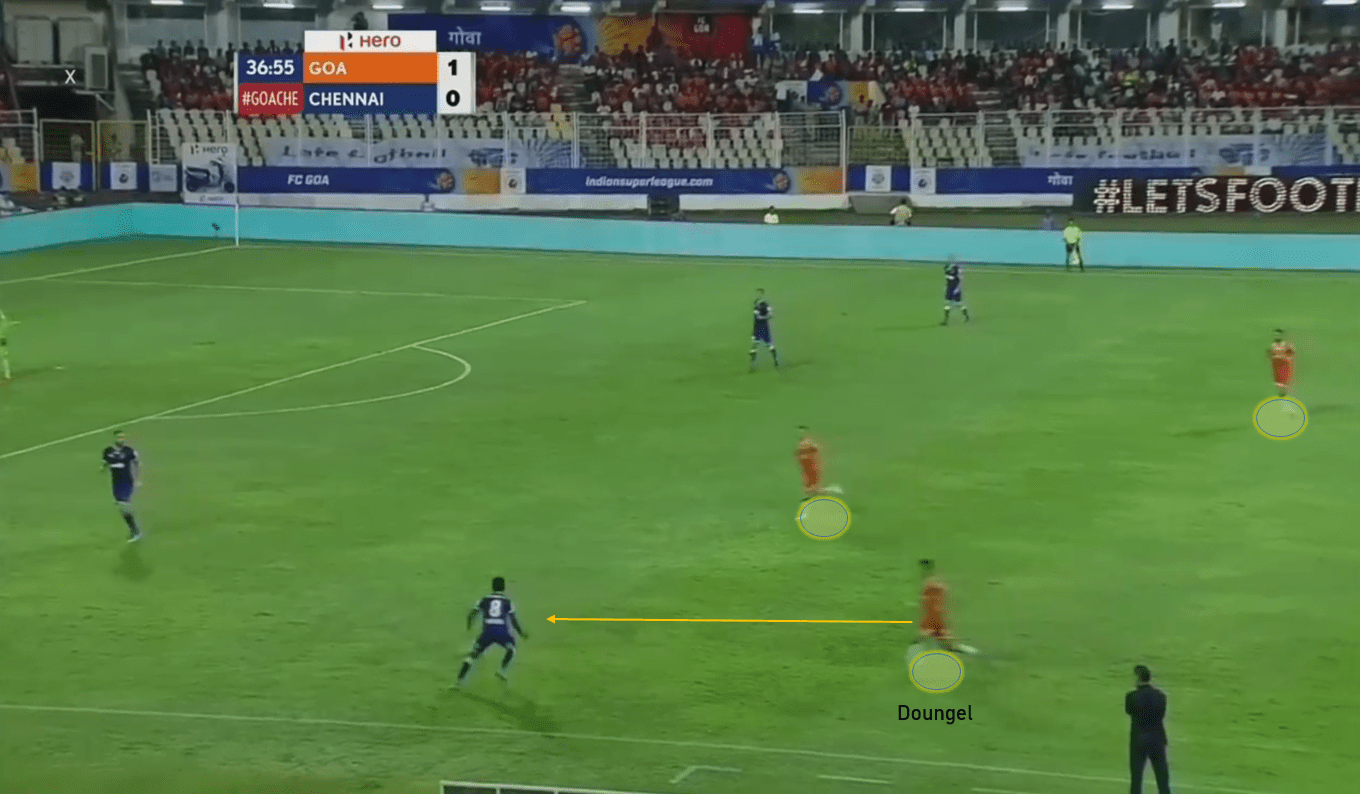
In the game against Chennaiyin FC, Corominas and Manvir formed the front two while pressing. They kept a distance from the Chennaiyin centre-backs and blocked the passing lane to the midfield. It prompted the right centre-back to pass it wide to the right-back. When that happened, the left-winger, Doungel pounced onto him and stuck to him like an Earthworm, eventually forcing the right-back to a turnover.
Sometimes, the Gaurs press aggressively in the final third itself and man-marks each opposition.
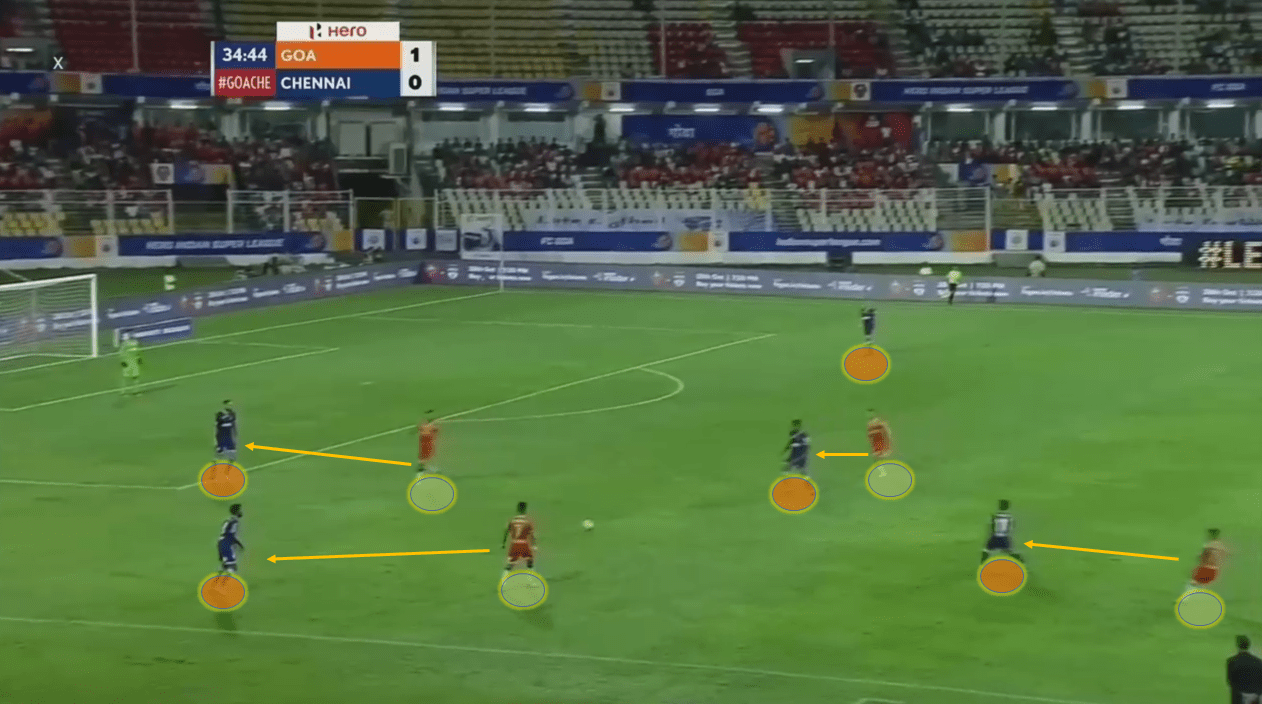
Here, striker Manvir Singh is on the Chennaiyin right centre-back. Doungel presses the right-back. Corominas presses the Chennaiyin midfielder aggressively when a pass is played to him. Mandar moves up to press the right-winger and the midfielders block the passing lane forward. The only option available is the left centre-back in the picture. FC Goa right-winger, Jackichand Singh, marked the opposition left-winger and kept tabs on the right centre-back from a distance.
If the ball is played to the right centre-back, Jackichand can move up to aggressively press the left centre-back and Seriton, the right-back can provide cover by keeping tabs on the Chennaiyin left-winger. But none of this happened since Goa pressed the opposition too aggressively giving very little time for the opposition to change the flank.
However, when the opposition have tackled the aggressive pressing and enters the midfield third, the Gaurs creates three blocks of four, three and three players.
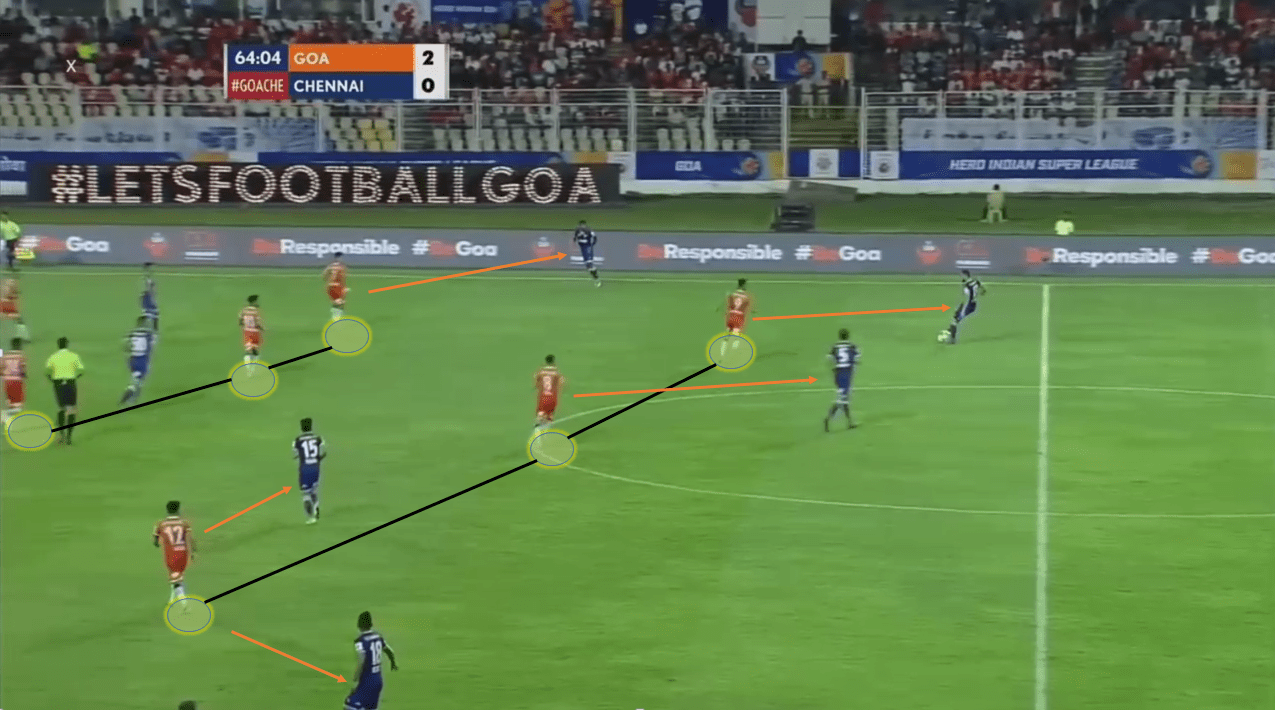
Just before this screenshot, the ball was on the left side of the field. In that situation, the FC Goa front three of striker, attacking midfielder and the right-winger was inclined towards the left side of the block and the second line of defence were inclined towards the other side thus covering the entire field.
When the ball was circulated on the right-hand side of the field, Manvir moved left to mark the right centre-back, Corominas kept tabs on the left centre-back. Doungel covered the opposition right-back and the Goa left-winger kept tabs on both the midfielder as well as the left-back. Brandon and Lenny kept the midfield compact and cage the other Chennaiyin midfielder.
This screenshot doesn’t show the third line of defence. However, Goa keeps the space between the second line of defence and the third very short. In this picture, the Goa left-back is visible at the far end keeping a tab on the Chennaiyin right-winger and keeping the distance between the two defensive lines short.
How did Sergio Lobera bring about a revolution in Indian football?
India not long back used to play a lot of meaningless long balls in the final third to influence the game. However, this attitude always held India back.
Sergio Lobera replaced the legendary Zico as the head coach of FC Goa in 2017 and he took the league by a storm with his high tempo passing football. Before Spaniard’s arrival, Bengaluru FC had the highest number of passes in a season averaging 411 passes per90 mins. FC Goa in 2016-17 played 320 passes per90 mins. Sergio Lobera took the charge in 2017-18 and the difference was clearly visible. In Lobera’s first season, FC Goa played 500 passes per90 mins, which was huge.
It also instigated the other teams to indulge in more passing and the season average increased enormously in terms of passes. Lobera also implemented one-touch passing or quick passes before troubling the defender with a defence splitting long ball. The average passes per minute increased to 16.93 in Lobera’s first season which lingered around 13 passes per minute previously. The passes per possession stats also increased enormously.
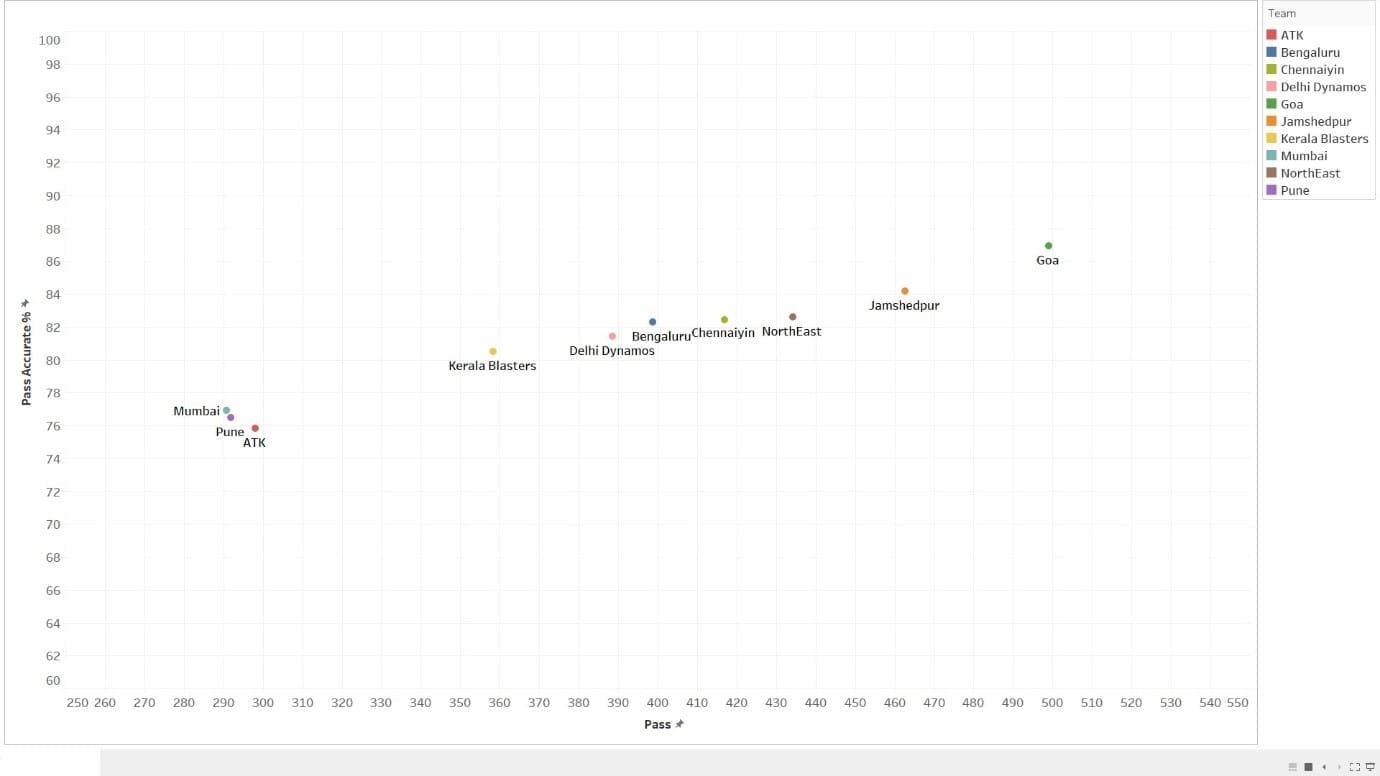
In 2018-19, the Gaurs played approximately 500 passes per90 mins in the season with an accuracy of 85%. Except for Mumbai FC, Pune City and ATK, all other teams had more than 350 passes with an accuracy of more than 80% passes. Before 2017 the teams hardly played 400 passes and all lingered in the 70%s when it came to passing accuracy. This is a huge leap for Indian football.
In January of 2018, only one player from FC Goa was in the mix for a call-up to the national squad. Now, four players regularly feature for the Indian national team and one gets called up sometimes.
Sergio Lobera also focusses on academy players and does not deter from giving chances to young Indian players. In the first game against Chennaiyin FC, the Gaurs finished the game with six local players which is maximum by any team until now.

If you love tactical analysis, then you’ll love the digital magazines from totalfootballanalysis.com – a guaranteed 100+ pages of pure tactical analysis covering topics from the Premier League, Serie A, La Liga, Bundesliga and many, many more. Buy your copy of the December issue for just ₤4.99 here





Comments